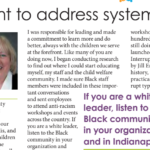

Child Advocates Featured in IBJ Diversity and Inclusion Issue
Posted on July 10th, 2020
On July 3, the Indianapolis Business Journal published a special Diversity and Inclusion issue. Child Advocates is proud to stand with 76 other local businesses that supported this important publication. The column below, written by Child Advocates CEO Cindy Booth, was published in the July 3 issue of the IBJ. Read the entire publication here.
If you want to address systemic racism, look within
In 2005, I was nearly a decade into my role as the CEO of Child Advocates when I saw a statistic in a monthly report that stopped me in my tracks—70% of the children who had come into the Marion County child welfare system during that month were Black.
“How can this be acceptable?” Our Chief Program Officer, Gregg Ellis, and I wondered. At the time, Black children made up approximately 11% of the county’s child population. Additionally, there is no evidence that people of color are more likely to abuse their children than white people. We decided to find a way to address the disproportionality of black children in the child welfare system, and, more importantly, find a way for us to improve. There were, and still are, more children of color in the child welfare system because of systemic racism. Finding the solution to this deeply-rooted issue, would be challenging.
First, I took a close look at the agency I was responsible for leading and made a commitment to learn more and do better, always with the children we serve at the forefront. Like many of you are doing now, I began conducting research to find out where I could start educating myself, my staff and the child welfare community. I made sure Black staff members were included in these important conversations and sent employees to attend anti-racism workshops and events across the country. If you are a white leader, listen to the Black community in your organization and in Indianapolis.
When my colleague Andrea Manning-Dudley, a Black woman who at the time had been a longtime advocate for children, came back from an Undoing Racism workshop in Texas, she told me, “I found the workshop we should bring to Indy.” Trusting Andrea wholeheartedly, I made a phone call to The People’s Institute for Survival and Beyond, the organization that facilitated this workshop.
In February of 2010, Child Advocates hosted its first Undoing Racism workshop and now, ten years and hundreds of workshops later, we are still doing this work. Last year, we launched our own program called Interrupting Racism for Children, led by Jill English, with local trainers, local history, and an emphasis on sharing practical tools for participants to interrupt typical responses, processes, and determine actions to create a better world for children.
We learned more and did better, eventually taking a leadership role in anti-racism work within the CASA network and Indianapolis-area. And while I’m proud of this, I’m equally pleased with what I see when I look at our organization today. Not only do we have a talented and compassionate team, the racial makeup of our employee population more closely mirrors the child welfare system, allowing us the ability to reflect and represent the children we serve.
Child Advocates didn’t always resemble the epitome of diversity and inclusion, and change did not happen overnight. But from the moment I noticed that stunning statistic 15 years ago, we never wavered in our commitment to race equity. I am grateful to my fellow leaders who went on this journey alongside me and held me accountable to create and sustain an equitable workplace. Since that time, our nonprofit has grown from 40 employees to 90 employees, and I’m happy to report that more than half of the leadership team and staff are people of color.
Business leaders often ask me, “How it is possible to create a truly racially diverse workforce?” This can be particularly daunting when you realize how much work is ahead of you, but I encourage you to stay the course. Believe me, if we can do it, so can you.
Sitting on the sidelines hoping for racial equity to happen will not work. So as a leader, what can you do? My greatest piece of advice is to look within, listen to the Black community, and learn. Racism exists today because of systems and practices that are still in place, perhaps even in your company. We are all responsible for ending systemic racism. Now is the time to act, intentionally and with purpose, to make Indianapolis the anti-racist city our children deserve.